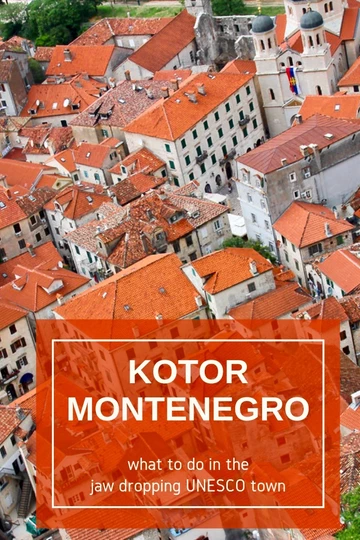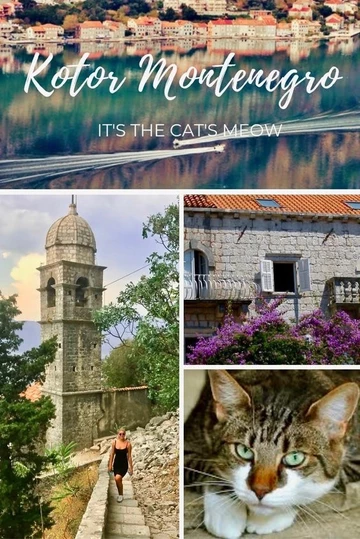Here’s my guide to visiting the beautiful town of Kotor Montenegro.
Set in the fjord-like Bay of Kotor, jaw dropping Kotor is less a town than a labyrinth of narrow cobbled passageways, filled mostly with cats, who sprawl across the doors of lovely Romanesque churches and snuggle in tourists’ laps. Kotor’s one of Europe’s most picturesque villages.
Sounds irresistible, doesn’t it? To me, it was. I was bowled over by its charm and its authentic, untouched nature.
Not surprisingly, the ancient walled town of Kotor Montenegro is a UNESCO World Heritage Site. It’s easily one of the best preserved medieval towns in the Adriatic.
Kotor lies, perfectly at ease with its dramatic setting, at the end of the photogenic Bay of Kotor and against the backdrop of the brooding Lovcen Mountains. Some call it Europe’s southernmost fjord. Others refer to it as a “little Dubrovnik.”
Different Than Dubrovnik
Having ventured to Kotor from Dubrovnik, the latter nickname seemed inaccurate.
Kotor is less ambitious, less ostentatious, and much smaller than its more celebrated neighbor. It’s even a bit scruffy and wild, with grass growing between the stones, tiles, and rusted iron. It has a special spice, despite the sometime sea of human cruise traffic mid day in the summer.
Things To Do in Kotor
There’s delightfully little to do in Kotor. There is no long “must see” list. You can pack away your guide books and maps, and venture forth with only camera and imagination in tow.
There are only four essentials: wander the picturesque Venice-like old town, hike to the Castle of San Giovani for spectacular views (which I’ve described in another blog post), admire the confident and ubiquitous Kotorian cats, and try a hot oily Montenegrin burek.
There are some fun detours too.
Strolling The Old Town
1. Weapons Square
When you enter the main gate, you arrive at Weapons Square, the largest open space in Kotor. There you will find Kotor’s Clock Tower, which dates from the early 17th century. It endearingly leans and lurches slightly, as befitting a historic building.
Kotor is custom-built for aimless strolling with narrow winding streets and tiny medieval squares. So if you are a flaneur, this is the place for you. It was for me. I had a delightful time poking in and out of the stone buildings and tiny alleys with my daughter.
2. St. Tryphon Cathedral & The Venetian Palaces
Kotor is also filled with Romanesque churches and Venetian-influenced palaces. None of them are individually very impressive All of them add to the atmospherics of the small town.
To get your dose of culture, start with the Romanesque church of St. Tryphon, also known as Kotor Cathedral, which is Kotor’s most impressive building and most recognizable landmark.
Originally built in 1166, it has been extensively reconstructed and restored several times following earthquakes. The church is dedicated to Kotor’s patron saint and martyr, Saint Tryphon. It has an agreeable pink columned interior with nice relics and frescos.
3. Fountain of Krampana
Near the cathedral, you’ll also find the Fountain of Krampana, steeped in mythology like everything else in Kotor. And who doesn’t like a good medieval myth?
The legend holds that a fairy told the Emperor Stefan to build Kotor on the idyllic bay, not in the craggy cliffs as he had initially planned with little foresight. But the sorry man forgot to properly credit the fairy for her brilliant suggestion.
As revenge, the fairy poisoned the water supply, driving the locals insane. After the Emperor properly apologized, the fairy relented. She magically cured the citizens and installed the Krampana Fountain. Until the 20th century, it was Kotor’s only source of clean water.
When you’re done with fairy myths and want some cultural inspiration, drop in on some Orthodox churches.
Among others, there’s the 17th century Pima Palace, beautiful despite it’s slightly crumbling baroque balustrade, the 18th century Beskuca Palace with a gothic portal depicting a lion, and the well preserved 12th century St. Luke’s Church.
4. Cats Of Kotor
I’m a cat person. I’m the owner of a buddy Ragdoll and a playful Bengal kitten. I miss them when I am out and about on my geographical cures.
Most cat people get their cat fix on youtube or by following Sukiicat on Instagram. Kotor, on the other hand, is literally awash in cats and they are part of the town’s daily life. There are cats perched atop ancient walls, lazing in church doorways, and sprawled through tiny alleyways in and around shops and cafes.
And they are singularly confident cats. They like to be pet, snuggled, and given treats. They seem fearless, friendly, mostly clean, and well fed.
Montenegrians love their self-created cat paradise.
Another of its ubiquitous legend holds that cats were brought to Kotor by maritime ships and “saved” Kotor from the then rampant mice, rats, and snakes. Cats came to symbolize good luck. They are now venerated, a miniaturized version of the Venetian Lion, which is the symbol of Kotor.
Emblazoned cat souvenirs and paraphernalia abound. There is even a quirky cat museum in a former monastery, the Museo del Gatto di Cattaro, which opened in 2017 and feeds stray cats with part of its € 1 entry fee. The collection of postcards featuring cats doing “human things” is particularly amusing.
While we passed on the cat trinkets, we did purchase some lovely pottery in a shop which, along with its beautiful ceramics, had a few cats.
5. In Praise of the Burek
A real delicacy of Montenegro is the burek, a filo pastry pasty that comes in all shapes — tubes, wedges, or spirals. And it is stuffed with all different ingredients — cheese, spinach, meat, and potatoes. Some are even drizzled in chocolate, for those with a sweet tooth.
It’s the perfect breakfast or post hike snack and can be found in any bakery in Kotor. The oily crunch pastry is not to be missed, one of the many delights of visiting the quaint town. Try Mamma Mia bakery on Trg od Brasna (Brasna Square).
6. Detour from Kotor: Quaint Perast
If you’re staying overnight and not just day tripping to Kotor, head 30 minutes down the bay and visit the tiny village of Perast.
This sleepy little town has a population of under 400, but a magical setting. You will have you snapping photos right and left. Despite having only one main street, Perast is chock full of Baroque and Venetian churches and palaces.
The biggest draw is St. Nicholas’ Church. Construction began in the 17th century, but it was never completed. Climb the imposing bell tower (€1) for impressive views over the bay.
Aside from strolling the pedestrianized streets, you can take a 10 minute boat ride to the 17th century Our Lady of the Rocks church on a man made island in the bay.
7. Visit the Blue Cave
Another lovely detour from the city center is to the Blue Cave. It’s a must see Montenegran attraction on the coast. From Kotor, wind down the Adriatic coast to the Herceg Novi Marina. From there, it’s a 30 minute boat ride.
The Blue Cave is a beautiful sea cave. It glows an eerie turquoise color. This happens when the sun is reflected off the sandy bottom.
Spend some time in the beguiling Kotor. It’s literally and figuratively the cat’s meow.
Practical information and Tips for Visiting Kotor:
St. Tryphon Church (Kotor Cathedral)
Trg Sv. Tripuna, Stari grad 366, Kotor 85330,
+382 32 322 315
Entry fee: 2.5 euros
Pima Palace
Trg od brasna, Stari grad, Kotor 85330
Beskuca Palace, now Hotel Marija
Stari grad 449, Kotor 85330
St. Luke’s Church
Trg Sv. Luke, Stari grad, Kotor
Cat Museum, Museo del Gatto di Cattaro
Trg Gospa od Anđela, Stari Grad 371 85330 Kotor
Entry fee: 1 euro
Tourist Office
Trg od Oru ja, Kotor
+382 32 325 950
If you liked it, pin it!


